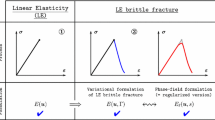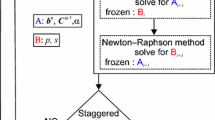Abstract
Phase-field models have been a topic of much research in recent years. Results have shown that these models are able to produce complex crack patterns in both two and three dimensions. A number of extensions from brittle to ductile materials have been proposed and results are promising. To date, however, these extensions have not accurately represented strains after crack initiation or included important aspects of ductile fracture such as stress triaxiality. This work describes a number of contributions to further develop phase-field models for fracture in ductile materials.
Access this chapter
Tax calculation will be finalised at checkout
Purchases are for personal use only
Similar content being viewed by others
References
M. Ambati, T. Gerasimov, L. De Lorenzis, Phase-field modeling of ductile fracture. Comput. Mech. 55(5), 1017–1040 (2015)
M. Ambati, R. Kruse, L. De Lorenzis, A phase-field model for ductile fracture at finite strains and its experimental verification. Comput. Mech. 57(1), 149–167 (2016)
L. Ambrosio, V.M. Tortorelli, Approximation of functional depending on jumps by elliptic functional via \(\Gamma \)-convergence. Commun. Pure Appl. Math. 43(8), 999–1036 (1990)
H. Amor, J.J. Marigo, C. Maurini, Regularized formulation of the variational brittle fracture with unilateral contact: numerical experiments. J. Mech. Phys. Solids 57(8), 1209–1229 (2009)
Y.-L. Bai, T. Wierzbicki, A new model of metal plasticity and fracture with pressure and Lode dependence. Int. J. Plast. 24, 1071–1096 (2008)
Y.-L. Bai, T. Wierzbicki, Application of extended mohr-coulomb criterion to ductile fracture. Int. J. Fract. 161, 1–20 (2010)
Y.-B. Bao, T. Wierzbicki, On fracture locus in the equivalent strain and stress triaxiality space. Int. J. Mech. Sci. 46, 81–98 (2004)
M.J. Borden, C.V. Verhoosel, M.A. Scott, T.J.R. Hughes, C.M. Landis, A phase-field description of dynamic brittle fracture. Comput. Methods Appl. Mech. Eng. 217–220, 77–95 (2012)
M.J. Borden, T.J.R. Hughes, C.M. Landis, C.V. Verhoosel, A higher-order phase-field model for brittle fracture: formulation and analysis within the isogeometric analysis framework. Comput. Methods Appl. Mech. Eng. 273, 100–118 (2014)
B. Bourdin, G.A. Francfort, J.-J. Marigo, Numerical experiments in revisited brittle fracture. J. Mech. Phys. Solids 48(4), 797–826 (2000)
B. Bourdin, G.A. Francfort, J.-J. Marigo, The variational approach to fracture. J. Elast. 91(1–3), 5–148 (2008)
B. Bourdin, C. Larsen, C. Richardson, A time-discrete model for dynamic fracture based on crack regularization. Int. J. Fract. 168(2), 133–143 (2011)
B. Bourdin, C.P. Chukwudozie, K. Yoshioka, A variational approach to the numerical simulation of hydraulic fracturing, in Proceedings of the 2012 SPE Annual Technical Conference and Exhibition, volume SPE 159154 (Society of Petroleum Engineers, 2012)
P. Bridgman, Studies in Large Plastic Flow and Fracture (McGraw-Hill Book Company, London, 1952)
S. Burke, C. Ortner, E. Süli, An adaptive finite element approximation of a generalized Ambrosio-Tortorelli functional. Math. Models Methods Appl. Sci. 23(9), 1663–1697 (2013)
G.A. Francfort, J-J. Marigo, Revisiting brittle fracture as an energy minimization problem. J. Mech. Phys. Solids 46(8), 1319–1342 (1998)
A. Ghahremaninezhad, K. Ravi-Chandar, Ductile failure behavior of polycrystalline al 6061–t6. Int. J. Fract. 174(2), 177–202 (2012)
A.L. Gurson, Continuum theory of ductile rupture by void nucleation and growth—Part I. Yield criteria and flow rules for porous ductile media. J. Eng. Mater. Technol. 99, 2–15 (1977)
M.E. Gurtin, Generalized Ginzburg-Landau and Cahn-Hilliard equations based on a microforce balance. Phys. D: Nonlinear Phenom. 92(3–4), 178–192 (1996)
S.S. Halton, S. Kyriakides, K. Ravi-Chandar, Ductile failure under combined shear and tension. Int. J. Solids Struct. 50, 1507–1522 (2013)
M. Hofacker, C. Miehe, A phase field model of dynamic fracture: robust field updates for the analysis of complex crack patterns. Int. J. Numer. Methods Eng. 93(3), 276–301 (2013)
G.R. Johnson, W.H. Cook, Fracture characteristics of three metals subjected to various strains, strain rates, temperatures and pressures. Eng. Fract. Mech. 21, 31–48 (1985)
C.J. Larsen, Models for dynamic fracture based on Griffith’s criterion, in IUTAM Symposium on Variational Concepts with Applications to the Mechanics of Materials, vol. 21, ed. by K. Hackl (Springer, Netherlands, 2010), pp. 131–140
C.J. Larsen, C. Ortner, E. Süli, Existence of solutions to a regularized model of dynamic fracture. Math. Methods Models Appl. Sci. 20(7), 1021–1048 (2010)
C. McAuliffe, H. Waisman, A unified model for metal failure capturing shear banding and fracture. Int. J. Plast. 65, 131–151 (2015)
F.A. McClintock, A criterion for ductile fracture by the growth of holes. J. Appl. Mech. 35, 363–371 (1968)
C. Miehe, M. Hofacker, F. Welschinger, A phase field model for rate-independent crack propagation: robust algorithmic implementation based on operator splits. Comput. Methods Appl. Mech. Eng. 199(45–48), 2765–2778 (2010a)
C. Miehe, F. Welschinger, M. Hofacker, Thermodynamically consistent phase-field models of fracture: variational principles and multi-field FE implementations. Int. J. Numer. Methods Eng. 83(10), 1273–1311 (2010b)
C. Miehe, M. Hofacker, L.-M. Schänzel, F. Aldakheel, Phase field modeling of fracture in multi-physics problems. Part II. Coupled brittle-to-ductile failure criteria and crack propagation in thermo-elastic-plastic solids. Comput. Methods Appl. Mech. Eng. 294, 486–522 (2015a)
C. Miehe, L.-M. Schänzel, Phase field modeling of fracture in rubbery polymers. Part I. J. Mech. Phys. Solids 65, 93–113 (2014)
C. Miehe, L.-M. Schänzel, H. Ulmer, Phase field modeling of fracture in multi-physics problems. Part I. Balance of crack surface and failure criteria for brittle crack propagation in thermo-elastic solids. Comput. Methods Appl. Mech. Eng. 294, 449–485 (2015b)
C. Miehe, F. Aldakheel, A. Raina, Phase field modeling of ductile fracture at finite strains. a variational gradient-extended plasticity-damage theory. Int. J. Plast. (in press) (2016). doi:10.1016/j.ijplas.2016.04.011
A. Mikeli\(\grave{{\rm c}}\), M.F. Wheeler, T. Wick, A phase-field method for propagating fluid-filled fractures coupled to a surrounding porous medium. Multiscale Model. Simul. 13, 367–398 (2015)
D. Mumford, J. Shah, Optimal approximations by piecewise smooth functions and associated variational problems. Commun. Pure Appl. Math. 42(5), 577–685 (1989)
J.R. Rice, D.M. Tracey, On the ductile enlargement of voids in triaxial stress fields. J. Mech. Phys. Solids 17, 201–217 (1696)
D. Schillinger, L. Dedè, M.A. Scott, J.A. Evans, M.J. Borden, E. Rank, T.J.R. Hughes, An isogeometric design-through-analysis methodology based on adaptive hierarchical refinement of NURBS, immersed boundary methods, and T-spline CAD surfaces. Comput. Methods Appl. Mech. Eng. 249–252, 116–150 (2012)
M.A. Scott, D.C. Thomas, E.J. Evans, Isogeometric spline forests. Comput. Methods Appl. Mech. Eng. 269(0), 222–264 (2014)
J.C. Simo, T.J.R. Hughes, Computational Inelasticity (Springer, New York, 1998)
H. Stumpf, K. Hackl, Micromechanical concept for the analysis of damage evolution in thermo-viscoelastic and quasi-brittle materials. Int. J. Solids Struct. 40(6), 1567–1584 (2003)
V. Tvergaard, A. Needleman, Analysis of the cup-cone fracture in a round tensile bar. Acta Metallurgica 32, 157–169 (1984)
K.G. Webster, Investigation of close proximity underwater explosition effects on a ship-like structure using the multi-material arbitrary Lagrangian Eulerian finite element method. Master’s thesis, Virginia Polytechnic Institute and State University, Jan 2007
Z.A. Wilson, M.J. Borden, C.M. Landis, A phase-field model for fracture in piezoelectric ceramics. Int. J. Fract. 183(2), 135–153 (2013)
Acknowledgements
This work was partially supported by Grants from the Office of Naval Research under contract number N00014-08-1-0992 and the Army Research Office under contract number W911NF-10-1-0216. T.J.R. Hughes, A. Anvari, and C.M. Landis were also supported by ARO grant number W911NF-13-1-0220. This support is gratefully acknowledged. The authors also acknowledge the Texas Advanced Computing Center (TACC) at The University of Texas at Austin for providing HPC and visualization resources that have contributed to the research results reported within this paper. URL: http://www.tacc.utexas.edu.
Author information
Authors and Affiliations
Corresponding author
Editor information
Editors and Affiliations
Rights and permissions
Copyright information
© 2018 Springer International Publishing AG
About this chapter
Cite this chapter
Borden, M.J., Hughes, T.J.R., Landis, C.M., Anvari, A., Lee, I.J. (2018). Phase-Field Formulation for Ductile Fracture. In: Oñate, E., Peric, D., de Souza Neto, E., Chiumenti, M. (eds) Advances in Computational Plasticity. Computational Methods in Applied Sciences, vol 46. Springer, Cham. https://doi.org/10.1007/978-3-319-60885-3_3
Download citation
DOI: https://doi.org/10.1007/978-3-319-60885-3_3
Published:
Publisher Name: Springer, Cham
Print ISBN: 978-3-319-60884-6
Online ISBN: 978-3-319-60885-3
eBook Packages: EngineeringEngineering (R0)




